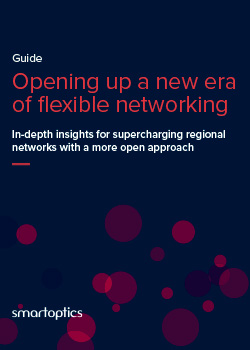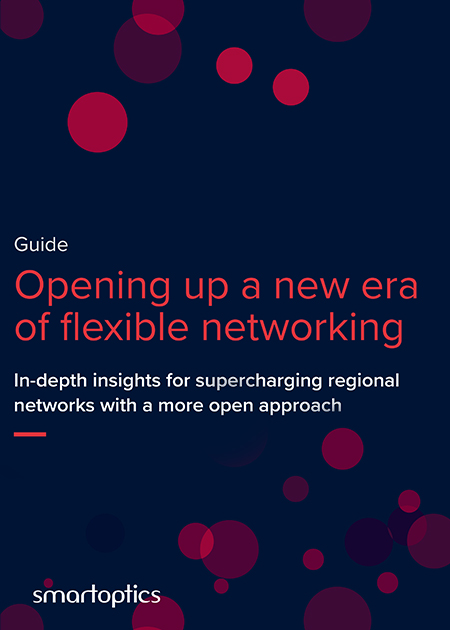The benefits of 400ZR for regional networks
Rural broadband service providers (BSPs) face increasing data traffic as the connected society takes hold, which puts pressure on backbone network performance. This has driven the development of 400ZR for enabling 400G speeds with flexible hardware configurations. While 400ZR started out as a standard for enterprise data center interconnection, the original standard was later expanded into multiple versions catering to BSPs both large and small. Rural BSPs can achieve both capacity and cost efficiency improvements by choosing the right 400ZR standard equipment.

Why OpenZR+ is the most attractive 400ZR standard for regional networks
The initial focus of the 400ZR project was on 400G Ethernet with amplified point-to-point DWDM links for DCI up to 120 KM and unamplified, single wavelength links with a loss budget of 11dB. Then 400ZR+ came along to meet communication service provider needs and extended the range beyond 120 km and enabled a 4x 100G client rate as opposed to only 1x 400G.
OpenZR+ was born out of the goal of taking the best of the 400ZR+ and the Open ROADM standards. OpenZR+ aims to combine simplified functionality, high-performance oFEC and interoperability tailored to the needs of regional networks. OpenZR+ adds more flexibility to the line rate and line modulation along with interoperability missing from 400ZR+ and will eventually replace 400ZR+.
When referring to 400ZR broadly, we mean all three standards as a whole. Specifically, the original 400ZR standard by OIF can be called OIF400ZR to distinguish it from 400ZR+ and OpenZR+. The table shows the differing targets of the standards and how this has influenced the distances and rates supported.
| Name | OIF400ZR | 400ZR+ | OpenZR+ |
| Target application | Edge DCI | Vendor dependent | Regional networks |
| MSA | Yes | No | Yes |
| Mid span | Yes | No | Yes |
| Distance | 80-120km | ≥ 120km | ≥ 120km |
| Client rate | 400GE | 400GE / 4x 100GE | 100GE/200GE/400GE |
| Line rate | 400G | 400G | 100G/200G/300G/400G |
| Line modulation | DP-16QAM | DP-16QAM | DP-QPSK/DP-8QAM/DP-16QAM |
| FEC | CFEC | CFEC/oFEC/prop FEC | oFEC |
| Form factor | QSFP-DD/OSFP/CFP2 | QSFP-DD/OSFP/CFP2 | QSFP-DD/OSFP/CFP2 |
400ZR standardization enables more flexible regional networks
Upgrading to 400ZR technology provides a higher level of standardization than previous standards, fueling the trend of disaggregated solutions. As a result, 400ZR makes it easier to mix and match network building blocks from different vendors. In this way, 400ZR enables more cost-efficient and less complex solutions for high-speed networking,
400ZR technology makes it possible to design solutions with greater interoperability, from transceivers and open line systems to open ROADMs and open management solutions. Rural CSPs can benefit from this by reducing vendor lock-in, increasing flexibility and deploying future-proof solutions.

The guide for a new era of flexible networking
Download our guide to discover a new path to flexible networking
The right 400ZR transceivers for future-proof regional networks
400ZR transceivers come in a couple varieties, and the two most interesting form factors for rural BSPs are QSFP-DD and OSFP. Both of these new form factors are pluggable. This makes them easy to deploy and manage in regional networks.
QSFP-DD improves on QSFP (QSFP+, QSFP28, QSFP56) by doubling the number of high-speed electrical interfaces – all the while still keeping largely the same convenient form factor. This leads to a jump from 40G or 100G aggregate to 200G or 400G, enabling total bandwidth of 14.4T for a single switch.
OSFP is a new form factor that is larger than QSFP-DD in all three dimensions, enabling higher power consumption. OSFP supports 400ZR with the same aggregate bandwidth per switch of 14.4T and 400G speeds although OSFP will also be able to support up to 800G in the future.
Although OSFP may be slightly more future-proof, QSFP-DD transceivers have been more popular with rural BSPs to date. This is largely because they are backwards compatible with previous QSWP system transceiver modules, which streamlines upgrades processes. For instance, QSFP-DD transceivers can be easily connected to existing switches and other infrastructure without having to replace everything.
400ZR solutions with Smartoptics give you flexibility
400ZR is a standardized format ideal for use with open line systems and well aligned with our open philosophy. This makes the technology key to unlocking greater cost efficiency and flexibility, giving you the freedom to choose best-of-breed network elements with the best value for money. Combining our open line systems with pluggable 400ZR transceivers will streamline your 400ZR upgrade process and future-proof your network. Enjoy highly automated, low-cost 100G networking while also gaining support for 400G.
Read more about how to get the most out of 400ZR and make your regional network more flexible in our guide “Opening up a new era of flexible networking.” And don’t hesitate to get in touch if you have any questions about 400ZR.

The guide for a new era of flexible networking
Download our guide to discover a new path to flexible networking

The guide for a new era of flexible networking
Download our guide to discover a new path to flexible networking
Related articles

Why hundreds of enterprises with mission-critical workloads choose Smartoptics for Brocade networking

Four reasons to choose Smartoptics for Brocade SAN DCI
